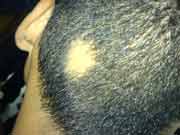
WEDNESDAY, June 30 (HealthDay News) — Researchers have implicated eight genes in the development of alopecia areata, a disorder that causes hair to thin and fall out.
The genes are already associated with other autoimmune diseases, including rheumatoid arthritis and type 1 diabetes, meaning that drugs may already be in the pipeline that could benefit people with hair loss, the researchers said.
“This greatly accelerated our ability to think about new drugs for patients with alopecia areata because so much work has already been done in these other diseases,” said senior study author Angela Christiano, professor of dermatology and genetics & development at Columbia University Medical Center in New York City. “It is a huge advantage.”
The study is published in the July 1 issue of Nature.
Alopecia areata affects more than 5 million people in the United States, according to the National Alopecia Areata Foundation, making it one of the most common autoimmune diseases. Hair loss may be confined to bald patches on the scalp, but in some cases it extends to the whole scalp or entire body, including eyebrows and eyelashes.
Men and women are affected equally, yet women are diagnosed more frequently because they are more likely to seek treatment. It’s a misconception that men suffer less from it, said Vicki Kalabokes, president and CEO of the alopecia foundation, which helped fund the research.
“It’s very traumatic for men, and it’s harder for them to cover it up,” Kalabokes said. “Hair loss is life-altering. You have lost your outward identity. You haven’t changed inside, but that’s not what’s seen by the world.”
The progression of the disease is unpredictable; some people may lose only a patch of hair, while others may lose all of the hair on their scalp over a few days, Kalabokes said. Hair loss can be especially difficult for children, she added.
The researchers discovered that the number of alopecia-associated genes a person had correlated with the severity of the condition. Those who carried 16 or more genes (the genes are in pairs) were more likely to progress to alopecia universalis, or total hair loss.
Researchers had expected that alopecia genes would be the same as those associated with other autoimmune diseases of the skin, such as psoriasis (in which the immune system signals the overproduction of skin cells, resulting in dry, scaly lesions) or vitiligo (loss of pigment to the skin when cells called melanocytes no longer function).
Yet alopecia and psoriasis had only one of the eight genes in common, Christiano said.
“We undertook this genome-wide association study to ask in an unbiased way, and to let the genes tell us, what are the likely associations with alopecia areata,” Christiano said. “We were very surprised to find the genes that came up have a mechanism shared by type I diabetes and rheumatoid arthritis.”
In people with alopecia, immune system T cells are present in large numbers in the hair follicle. Under a microscope, “it looks like the hair follicle is being swarmed or attacked by bees, which are the T cells,” she explained.
What researchers didn’t know was what attracted the “bees” in the first place, though the study hints at the answer.
Among the eight genes, one in particular — ULBP3 — has been shown to attract toxic cells that can invade and destroy an organ. In a person without alopecia, ULBP3 is turned off. But in people with alopecia, ULBP3 proteins are plentiful in the follicle.
“In people with alopecia areata, we see a huge expression of the ULBP3 gene in the outermost layer of the follicle,” Christiano said. “ULBP3 is a danger signal that signals to T cells to come in and attack the follicle. It’s like putting nectar on the hair follicle, then the ‘bees’ come in and do their damage.”
When the follicle is attacked, the hair falls out. If the T cells remain, which they do in alopecia areata, the follicle goes dormant.
No treatments are currently approved by the U.S. Food and Drug Administration for alopecia areata, Kalabokes said, although people sometimes pin their hopes on steroid injections into the scalp and other unapproved remedies.
More information
The National Alopecia Areata Foundation has more on the condition.

